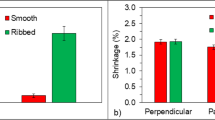Abstract
Much attention has been being given to the importance of product surfaces in the field of plastic parts, as industrial design has become one of the key elements of product success. These plastic parts incorporate rib-like geometries on the non-appearance surfaces of plastic in order to increase the stiffness of rigidity of the section, but they often cause appearance problems of the product’s surface overall by making a sink mark on that surface. The thickness, height and draft-angle of the rib are generally known as major parameters influencing the sink mark on the appearance surface. Therefore, designers of plastic parts must determine the variables of reinforcing ribs. The goal of this study is to find the optimum design variables in the mixing conditions of the thickness, the height and the draft angle of reinforcing ribs so that designers of plastic parts can easily determine the conditions of the reinforcing ribs as the part’s section thickness varies within an objective limit in polycarbonate plastic resin and a high glossy surface that are widely applied in the creation of plastic products. We investigated the actual depths of sink marks on the surface of a specimen that was manufactured with an injection mold specifically for this study. Response surface methodology with the Box-Behnken design was used to analyze the regression curve of real depths with combinations of the thickness, height and draft angle of the ribs. The result shows that the most influential factor to increase the shrinkage is the thickness of ribs and that the optimum value of the rib thickness is a range from multiple of 0.25 to 0.34 of the section thickness. Also, the rib height and rib draft angle are not major factors that can change the sink amount.
Similar content being viewed by others
References
R. A. Malloy, Plastic part design for injection molding, Second Ed. Hanser Gardner Publications, Cincinnati (2000).
D. V. Rosato, D. V. Rosato and M. G. Rosato, Plastics design handbook, Kluwer Academic Publishers (2000).
P. A. Tres, Designing plastic parts for assembly, Sixth Ed. Hanser Gardner Publications, Inc. (2006).
Technical Bulletin and R. Wekman, Engineering design, E. I. DuPont de Nemours & Co., Wilmington, DE. (1988).
M. Lion, SPE annual technical conference, 36 (1990) 288.
C. MacDermott, Selecting thermoplastics for engineering applications, Marcel Dekker, Inc., New York (1984).
J. Bralla, ed., Handbook of product design and manufacturing, McGraw Hill, New York, USA (1991).
General design principles for dupont engineering polymers; Information on http://www2.dupont.com.
Design solutions guide: Information on http://www.plasticportal.com/usa.
Information on http://www.sabic-ip.com.
Product design guide: Information on http://www.lgchem.com.
Rib design manual-technical issues: Information on http://www.samsungchemical.com.
Technical bulletin, Designing with plastics, Hoechst Celanese, Chatham, NJ (1989).
R. Criens and H. Mosle, Polymer engineering & science (1983).
L. Sors and I. Balazs, Design of plastic moulds and dies, Elsevier Publishers, New York (1989).
T. A. Osswald, E. Baur, K. Oberbach and E. Schmachtenberg, International plastics handbook, Hanser Gardner Publications, Cincinnati (2007).
Information on http://www.hitachimetals.com/product/specialtysteel/toolsteel.
Information on http://metrology.zeiss.com/industrial-metrology/en_us/products/systems/bridge-type-cmms/contura-g2.html.
F. Pukelsheim, Optimal design of experiments, SIAM (2006) 381–382.
D. C. Montgomery, Design and analysis of experiments: Response surface method and designs, John Wiley and Sons Inc., New Jersey (2005).
X. Zhang, W. Lu, P. Yang and W. Cong, Application of response surface methodology to optimize the operation process for regeneration of acid and base using bipolar membrane electrodialysis, Chem. Technol. Biotechnol., 83 (2008) 12–19.
G. E. P, Box and N. R. Draper, Empirical model-building and response surfaces, Wiley & Sons Inc. USA (1987) 424.
S. S. Shapiro and R. S. Francia, An approximate analysis of variance test for normality, Journal of the American Statistical Association, 67 (1972) 215–216.
Author information
Authors and Affiliations
Corresponding author
Additional information
Recommended by Guest Editor Haedo Jeong
Seong Won Jeong is a professor in the department of Product Design and Manufacturing Engineering in Seoul National University of Science and Technology, Korea. He is a regular member of Korean Society of Design Science (KSDS), Korean Society for Emotion & Sensibility (KSES). His research interests include product design, engineering design, design method, and Robot design. Product surface and tactile emotion are a recent focus of his studies.
Rights and permissions
About this article
Cite this article
Jeong, S.W. Conditions of rib design for polycarbonate resin with high glossy surfaces. J Mech Sci Technol 27, 3023–3028 (2013). https://doi.org/10.1007/s12206-013-0820-5
Received:
Revised:
Accepted:
Published:
Issue Date:
DOI: https://doi.org/10.1007/s12206-013-0820-5




